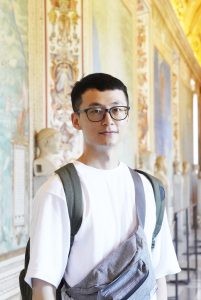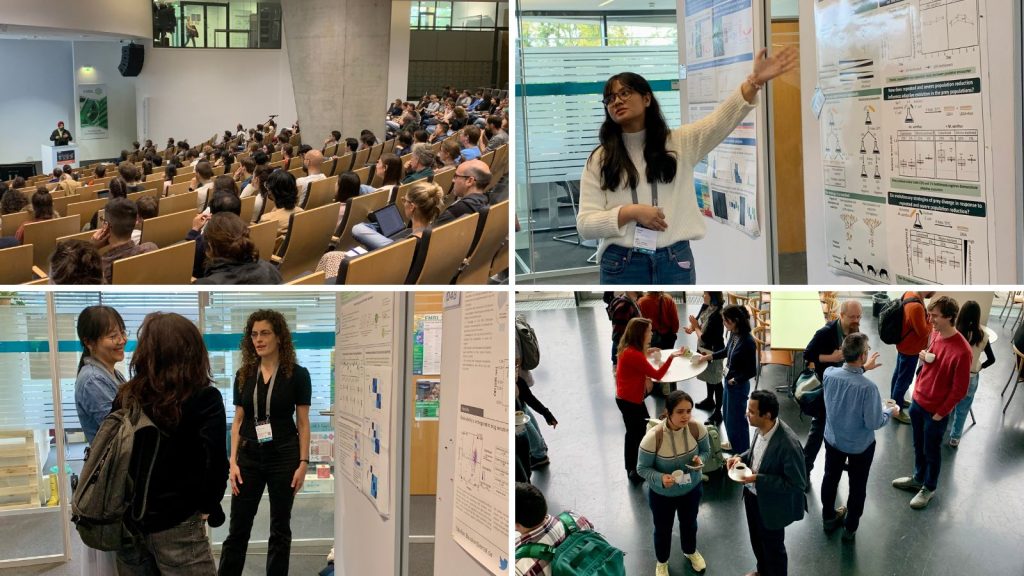Best poster prizes at ‘Molecular mechanisms in evolution and ecology’
The EMBO Workshop ‘Molecular mechanisms in evolution and ecology’ took place last month at EMBL Heidelberg.
The focus of this workshop was on interspecies and cell-environment interactions across living organisms, with a special focus on bacteria, microbial eukaryotes, and viruses. It highlighted the latest technological advances, amplified scientific and societal focus on biodiversity, and showcased studies on the vital role of microbes in planetary ecosystems.
With 204 onsite participants, 25 virtual participants, and 12 fellowships provided by the ‘EMBL Corporate Partnership Programme‘ and ‘EMBO‘, the ATC building gathered researchers from diverse fields and organismal systems, all united by a shared goal of addressing key ecological and evolutionary questions. Many attendees developed innovative experimental and computational approaches to gain deeper mechanistic insights.
With 139 posters displayed on Helix A, the poster sessions were dynamic and engaging, offering presenters the chance to share and discuss their research with peers. Each project was voted on by participants, adding a sense of excitement and community.
During this edition, we were delighted to award five poster prizes during the meeting, and we’re thrilled to present three of these outstanding contributions. Please join us in giving a round of applause to these brilliant minds.
Congratulations to our poster prize winners!
Molecular mechanisms of interspecies interactions in wine yeast communities
Presenter: Belen Benitez
Authors: Belen Benitez, Sergio Izquierdo-Gea, Miguel de Celis, Javier Ruiz, Alvaro Sanchez, Ignacio Belda

Abstract: Producing high-quality tailored wines requires understanding the functional roles of the diverse yeasts found in grape musts and comprehending the molecular basis of community-level processes emerging from inter-species interactions. Our study aims to understand how yeasts respond to biological interactions during wine fermentation. We used a collection of six wine yeast species with varying fermentative capacities, combined with Saccharomyces cerevisiae to construct 16 consortia of increasing diversity. We tested the performance of these consortia (metatranscriptome, fermentation kinetics and metabolite profile in the wines) in two distinct synthetic grape musts that differ in nitrogen source availability. We found a positive correlation between the taxonomic and functional diversity of wine yeast communities, with no significant impact from phylogenetic distance between species. The individual contributions of yeast species to the community metatranscriptome varied widely, but the functional diversity (i.e., new orthologs) contributed by each species decreased at higher diversity levels, indicating functional redundancy. Interestingly, it’s the functional diversity, rather than taxonomic diversity, that accounts for consistent performance across conditions. Communities with the greatest transcriptomic divergence from S. cerevisiae monoculture displayed the most functional consistency. We discovered a significant correlation between transcriptomic and metabolic profiles at the same fermentation stage. This suggests that we can potentially predict fermentation metabolites by understanding the functions occurring at that specific point in the fermentation process. Finally, we identified orthologs expressed in complex yeast communities that are not found in S. cerevisiae monoculture. This allows us to investigate the ecosystem functions not covered by that focal species, which we refer to as the ‘accessory’ part of the wine ecosystem metatranscriptome. Identifying the species covering such functions and studying their transcriptional regulation will aid in designing yeast consortia with predefined improved functions.
Due to the confidentiality of the unpublished data, we cannot share the poster.
A high-throughput imaging assay to quantify bacterial defense against protist predation
Presenter: Andrew Hogan
Authors: Andrew Hogan, Alexandra Koumoutsi, Nassos Typas, Jordi van Gestel

Abstract: Protists are major natural predators of bacteria, and thus present a strong driver towards the evolution of defense mechanisms. In the space of microbial “dark matter”, many uncharacterized genes likely function in natural settings, such as microbial interactions and predation defense. Current protist predation assays have limited throughput or give only course quantification. To probe a wider genetic space for discovering novel defense mechanisms, we developed a high-throughput assay to assess predation defense against the model protist, Dictyostelium discoideum. Fluorescent bacterial strains are robotically pinned in 384-format on agar plates then imaged with an automated Axio Zoom microscope to track predation and fluorescence signal over time. The platform gives excellent temporal and spatial resolution with rapid acquisition at magnifications down to single bacteria and amoeba. Individual plates can be imaged in continuous timelapse, or multiple plates can be imaged at intervals. A custom analysis pipeline then derives predation rates for each bacterial colony from the fluorescence intensity profiles over time. Predation rates are benchmarked to known strains with or without predation defense. To test our platform, we screened a library of 576 diverse E. coli isolates and found a spectrum of phenotypic resistance, enabling focused genetic studies. Overall, this quantitative assay offers substantially greater throughout and resolution compared to current plate-based assays. In the future, we aim to explore other protist-bacteria pairs to expand the microbial “dark matter” search space for new defense mechanisms.
Engineering biofilm communities as organic coatings on unmanned underwater vehicles (ECO-COATING Project)
Presenter: Nan Yang
Authors: Nan Yang, Amanda Jakobsen, Cristina Amador, Mette Burmølle

Abstract: Bacteria often live as spatially structured biofilms in nature including aquatic environments. However, biofilms can directly create a drag penalty, lowering energy efficiency, when formed on battery-powered craft, including unmanned underwater vehicles (UUVs). To address this problem with eco-friendly needs, we aim to develop microbial communities composed of natural marine microbes that can form smooth and stable biofilms to reduce drag and energy loss. Through experimental validation on PSX700 (an antifouling paint used for UUVs)-coated plates, we selected 9 out of top 30 adhering UUV isolates from initial adhesion screening (>160 isolates). The community assembly included all 9 monocultures and 7 multicultures consisting of 6 three-species and 1 nine-species communities. Among these 7 communities, COM6 was promising as showed synergistic adhesion on two materials, although it was not best community to form biofilm compared to other communities. Further, we quantified the stability of four assembled communities using CFU counts as a measure of adhesion, in those communities where the constituent isolates could have distinct colony morphology from each other. The composition in COM1, COM4, and COM6 remained initial species present after medium-changed growth, indicating the relatively stable species abundance in the three assembled communities. In this study, we found three communities that were more productive than monospecies biofilms and stable over time. Such communities are promising candidates for further testing in more operational conditions.

The EMBO Workshop ‘Molecular mechanisms in evolution and ecology‘ took place from 8 – 11 October 2024 at EMBL Heidelberg and virtually.